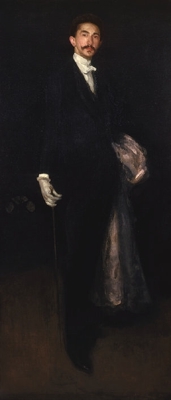 |
 |
|
From: The Frick Collection This portrait of Comte Robert de Montesquiou-Fezensac (1855–1921) . . .[is] one of the last large canvases Whistler finished. Though the artist and his subject had known one another since 1885, it was not until the spring of 1891 that work was begun on the portrait in Whistler’s London studio. After countless posing sessions, it was completed the following summer in a studio Whistler was renting in Paris [1]. It languished there for another two years, before being exhibited at the Salon of the Champ-de-Mars in 1894, where it provoked a flood of critical reviews, mostly enthusiastic. . . . Many contemporaries described it as being like an apparition — [which] relates it to symbolist currents of the 1890s. Whistler's desire to capture the soul of Montesquiou is suggested by his final words to the exhausted model: “Look at me for an instant longer, and you will look forever!” The garment shown hanging
over the
count’s left arm was a chinchilla cape belonging to his beloved cousin
and muse, Comtesse
Élisabeth Greffulhe. Today, Montesquiou is probably best
remembered
as one of the models for the personage of the Baron de Charlus in
Proust’s
A la recherche du temps perdu. . . Giovanni
Boldini (See Sargent's W. Grahm Robertson and Whistler's Montesquiou) Note:
|
